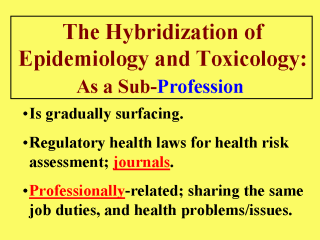 |
In contrast, as a sub-profession or specialized occupation, the hybridization of epidemiology and toxicology is more successful and gradually maturing. For example, those toxicologists certified as a Diplomate of American Board of Toxicology (DABT) are required to pass a portion of the Board’s examination in epidemiology. Recent workshops (WHO, 1995; NIH, 1999) calling for integration of exposure assessment with epidemiology and toxicology also reflect this hybridization trend. In the United States, the Texas Department of Health and the Ohio Department of Health each have a division or bureau named (Environmental) Epidemiology and Toxicology, with a very definite and defensible mission. There is also available today one international journal publication with the similar title
Environmental Epidemiology and Toxicology.
As pointed out in earlier slides, compliance with health laws often requires the performance of health risk assessment, which typically cannot be made with epidemiologic or toxicologic studies alone. It is also important to note that those health issues and concerns requiring the most public attention often are not purely academic, medical, or clinical, but rather environmental, in nature. To put it another way, the hybridization of epidemiology and toxicology is gradually surfacing, only simply because there is a need for epidemiologists and toxicologists to work in concert with one another in order to effectively and efficiently cope with public demands coming from all sectors of a population.
|
